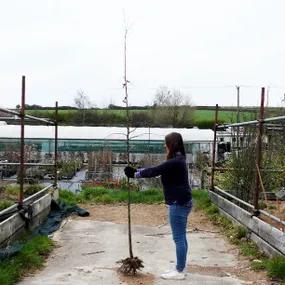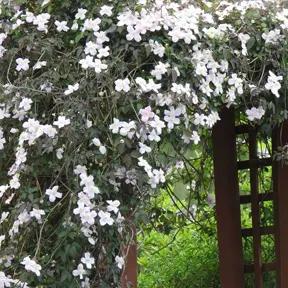Hornbeam, Large Trees
Delivered in Large Sizes
- European / Common Hornbeam
- Large Standard Trees ideal for ornamental or screening use.
- The fastigiate form is neater
- RHS Award of Garden Merit
- To 20-25m
- Bareroot trees for winter delivery (Nov-March) only.
Recommended extras
Description
Carpinus betulus: Bareroot Hornbeam Trees in Standard Sizes
Hornbeam, Carpinus betulus, is a fairly large, native, deciduous tree. Parkland hornbeam trees have dense, rounded canopies that cast full shade underneath them.
The green leaves look similar to those of beech, except for the more deeply crinkled veins and the jagged edges. The autumn colour is russet-gold. Hornbeam seeds have 3-lobed wings and are eaten mainly by small mammals, finches and tits.
It makes a beautiful parkland specimen, with a rounded, spreading canopy that casts deep shade underneath it.
Hornbeam can reach a height of about 25 metres.
You can also buy Fastigiate Hornbeam, which is more compact and upright than the wild variety on this page.
Standard trees are the largest size that we deliver; you can buy younger Hornbeam saplings, which are ideal for hedging.
Browse our large garden trees, or all of our trees.
Delivery season: Hornbeam trees are delivered bareroot during late autumn and winter, approximately November-March inclusive.
Choosing a size: Small trees are cheaper, easier to handle and more forgiving of less than ideal aftercare, so they are best for a big planting project. If instant impact is your priority, or if you are only buying a few plants for use in a place where it is convenient to water them well in their first year, then you may as well use bigger ones. All our bareroot trees are measured by their height in centimetres above the ground (the roots aren't measured).
Features:
- Height: 25m
- Large, spreading habit
- Soil: Any, shade-tolerant
- Native
- RHS Award of Garden Merit
- Bareroot delivery only: November-March
Growing Hornbeams
Hornbeams are versatile trees, only needing reasonably fertile soil. They love heavy clay, will tolerate shade and can be planted in the coldest regions and frost pockets.
The wood is very hard and can resist strong wind in exposed areas.
It is a superb screening tree that should need no pruning maintenance.
Hornbeam is the classic substitute for beech on wet or shady sites.
Planting Instructions
Notes on planting Hornbeam trees:
Hornbeam trees will grow well in any reasonably fertile soil. They thrive best on heavy clay and they will grow well in quite deep shade.
Although it is a hardy tree, Hornbeam will not grow well at altitude in the North and Scotland.
Prepare your site before planting:
It is good to dig over the site where you plant a tree several months in advance. Kill the weeds first: for tough weeds like nettles, brambles and ground elder, you will usually need a weed-killer to get rid of them. When you dig the soil over, remove stones and other rubbish and mix in well rotted compost or manure down to the depth of about 2 spades.
Watch our video on how to plant a tree for full instructions.
Remember to water establishing trees during dry weather for at least a year after planting.
Tree Planting accessories:
Prepare your site for planting by killing the weeds and grass.
You can buy a tree planting pack with a wooden stake & rubber tie to support the tree and a mulch mat with pegs to protect the soil around the base of your tree from weeds and drying out.
We suggest that you use mycorrhizal "friendly fungi" on the roots of all newly planted large trees: if your soil quality is poor, we strongly recommend it.
You can also improve your soil with bonemeal organic fertiliser.
Did You Know?
Hornbeam wood is extremely strong and in the past it was prized for weight-bearing beams in the walls and roofs of houses. It is excellent firewood, producing almost as much heat for a given volume of fuel as coal.
It isn't very good at propagating itself in Britain and Northern Europe because the seeds can take 3 years to germinate, during which time they are mostly eaten. If a seed does get to sprout, the sapling is unlikely to survive its first year. Hornbeam's true native range in Britain is limited to the South East; it is so common elsewhere because humans have planted it for coppicing since ancient times.
In old English, beam referred to a living tree, and horn refers to the hardness of the wood.
Other common names: Charmille, yoke elm, and horn, horse, hurst, or white beech.
Standard trees are measured by their girth in centimetres 1 metre above ground level: their trunk's waist measurement. Unlike sapling trees and hedge plants, standards aren't measured by their height, which will vary quite a bit both between and within species.
So, a 6/8cm standard tree has a trunk with a circumference of 6-8cm and an 8/10 standard has a trunk 8-10cm around. This measurement makes no difference to the tree's final height.
On average, standard trees are 2-3.5 metres tall when they arrive, but we cannot tell you precisely how tall your trees will be before we deliver them.
It's Summer Planting Season 2025

Pot Grown & Plug Plants Delivered

Direct from the Nursery Value

No more broken plants in the post!


 2.webp)
 2.webp)
 1.webp)
 3.webp)






